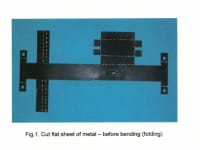Most home owners have a ladder. When they need to use it, it is typically difficult to access; when not needed it is usually in the way. In either case, it often poses a safety hazard. LadderBack was invented to solve a ladder storage problem. With a LadderBack system, the ladder is never in the way and yet readily accessible. A patent application has been filed with the United States Patent and Trademark Office. Prior art search (freepatentsonline.com) has not found any other similar system and therefore, I believe LadderBack is novel. No other ladder storage device has the same or similar attributes. While looking around my garage/shop, I noticed the one place that was not used for any particular storage: the backside (inside) of the overhead garage door. I made a ladder holding device that mounts on the hinges between two of the garage door panels. One leg of the ladder hooks on a top rail; the other leg is secured with a simple spring loaded plunger. The ladder (parallel to one of the door panels) goes up and down with the door. It can be mounted onto or dismounted from the holder only when the door is closed – in the vertical position. When the ladder is overhead (when the door is open) a gravity actuated safety mechanism does not allow release of the spring loaded latching mechanism. This safety element is protected in a sealed housing and, therefore, can not be defeated. There are only five individual parts that are needed to manufacture a completed LadderBack storage system. The main body is constructed from one piece of metal. The other four pieces are a plunger, the gravity actuated locking bar, a spring, and a rivet. Figure 1 shows the main body after cut from a flat sheet of metal, but before a series of fabrication bends and the safety method installation. By minimizing the individual parts, and by utilizing simple bends (folds), the cost of manufacturing is low. LadderBack would come in three standard sizes to accommodate the three standard garage door panel sizes. The top attachment rail could be made adjustable for different ladder widths. Further manufacturing simplifications and cost savings may be developed such as injection molding for one or more parts comprising the LadderBack system. LadderBack installation only requires two bolts or pins that slip through the top and bottom integrated brackets and the roll pins of the garage door hinges. Figure 2 shows a close-up view of a LadderBack mockup. Figure 3 shows the device in actual use. There are approximately 115 million households in the United States alone [http://www.census.gov/prod/1/pop/p25-1129.pdf]. [http://wiki.answers.com/Q/How_many_homes_are_there_in_the_US] claims there are 129.4 million homes in U.S. I assume the difference may be due to a portion of these are apartment dwellers. There are also numerous small businesses and apartment complexes that have integrated shop space. Together, the overall market is substantial.Anyone who has ever tripped over their ladder, or tripped getting to it, is a potential LadderBack customer!
Voting
-
ABOUT THE ENTRANT
- Name:Michael Potter
- Type of entry:individual
- Profession:
- Number of times previously entering contest:1
- Michael's favorite design and analysis tools:None
- For managing CAD data Michael's company uses:None
- Michael's hobbies and activities:Guitar, Welding, Gardening, Motorcycle, Nature
- Michael belongs to these online communities:None
- Michael is inspired by:I enjoy creative problem solving
- Hardware used for this entry:NoneSoftware used for this entry:None
- Patent status:pending








